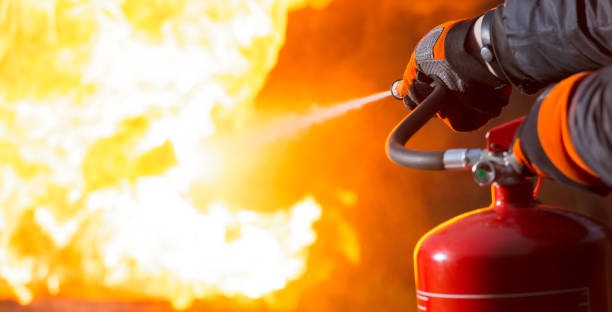
This article was originally published by nimbusweb.me. Read the original article here.
Fires can be devastating, causing significant damage to homes, businesses, and even human life. A fire extinguisher in the home or office can mean the difference between safety and danger. However, not all fire extinguishers are created equal, and it is essential to understand the different types of fire extinguishers and their service requirements.
Types of Fire Extinguishers
There are five primary fire extinguishers, each designed to extinguish different types of fires. These include:
Class A fire extinguishers are designed to put out fires caused by ordinary combustibles such as wood, paper, and cloth. They work by cooling the fuel source and removing heat from the fire. These extinguishers typically use water, foam, or dry chemicals as their extinguishing agent.
Class B fire extinguishers extinguish fires caused by flammable liquids such as gasoline, oil, and grease. These fires are dangerous because the fuel source can easily spread the flames.
Class C fire extinguishers are designed to prevent fires caused by electrical equipment, such as computers, appliances, and power tools. These types of fires are dangerous because of the potential for electrocution.
Class D fire extinguishers extinguish fires caused by combustible metals such as magnesium, sodium, and titanium. Because of the tremendous temperatures involved, these fires can be especially deadly. These extinguishers work by smothering the fire with a dry powder extinguishing agent.
Class K fire extinguishers are designed for commercial kitchens and are used to put out fires caused by cooking oils and fats. These fires can be dangerous because they can quickly spread and reignite. It smothers the fire with a wet chemical extinguishing agent that cools the fuel source and creates a barrier to prevent re-ignition.
Using the incorrect extinguisher type might be harmful or ineffectual. Having your fire extinguishers serviced regularly by a professional is also important to ensure they are in proper working order.
Fire Extinguisher Service Requirements
It is crucial to understand that the fire extinguisher service requirement for each type of extinguisher can vary. For example, Class A fire extinguishers typically require a simple visual inspection to check for any damage or corrosion, while Class K fire extinguishers used in commercial kitchens require more frequent inspections and servicing due to the high risk of fires caused by cooking oils and fats.
The National Fire Protection Association (NFPA) recommends that fire extinguishers be inspected monthly and serviced annually. During a routine service, a qualified technician will inspect the extinguisher to ensure it is in good working order, check for any damage or corrosion, and confirm that the green zone is visible on the pressure gauge.
The Final Words
Understanding the different types of fire extinguishers and their service requirements is essential for ensuring you are prepared for a fire. Regular maintenance and inspections are necessary to keep your fire extinguishers in good working order. If you want fire extinguisher service in San Antonio, TX, consider contacting Lone Star Fire and First Aid for all your fire safety needs.


No comments yet